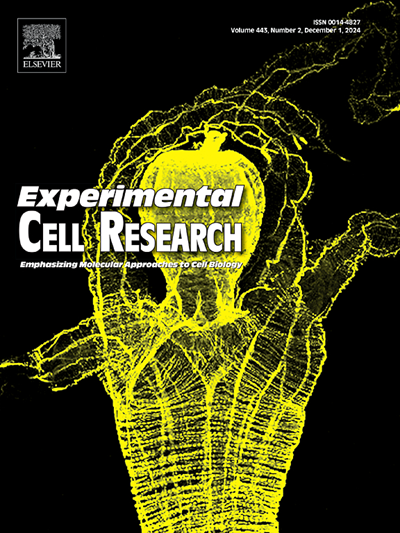利用动力蛋白敲除细胞进行全基因组CRISPR-Cas9敲除筛选,发现Nf2和Traf3是参与动力蛋白非依赖性内噬作用的基因。
IF 3.3
3区 生物学
Q3 CELL BIOLOGY
引用次数: 0
摘要
内吞是细胞吸收细胞外物质(包括营养物质、生长因子和病原体)的基本过程。虽然一些内吞途径,如凝胶蛋白介导的内吞和洞穴素介导的内吞,已经得到了很好的表征,但对其他内吞途径仍然知之甚少。因此,在本研究中,我们进行了一次全基因组的 CRISPR-Cas9 筛选,利用 dynamin 条件性基因敲除细胞来阐明新的内吞途径。我们发现了与达因明同时敲除时细胞数量明显减少的基因。其中,神经纤维瘤蛋白 2(Nf2)和肿瘤坏死因子受体相关因子 3(Traf3)与内吞活动的关系尚不十分清楚,我们研究了它们在内吞活中的作用。敲除 Nf2 和 Traf3 的细胞表现出非特异性液体内吞减少,其方式与动态蛋白无关。然而,Nf2或Traf3基因敲除并不影响转铁蛋白受体介导的、依赖于凝集素和达因明的内吞作用。此外,Nf2基因敲除细胞显示出霍乱毒素摄取的减少,而这种摄取是不依赖于动态蛋白的。总之,这项研究强调了Nf2和Traf3在内吞中的作用。本文章由计算机程序翻译,如有差异,请以英文原文为准。
A genome-wide CRISPR-Cas9 knockout screen using dynamin knockout cells identifies Nf2 and Traf3 as genes involved in dynamin-independent endocytosis
Endocytosis is a fundamental process by which cells take up extracellular materials, including nutrients, growth factors, and pathogens. Although several endocytic pathways, such as clathrin-mediated and caveolin-mediated endocytosis, are well-characterized, other endocytic pathways remain poorly understood. Therefore, in this study, we performed a genome-wide CRISPR-Cas9 screen to elucidate new endocytic pathways using dynamin conditional knockout cells. We identified genes that significantly reduced the cell numbers when knocked out simultaneously with dynamin. Among these, neurofibromin 2 (Nf2) and tumor necrosis factor receptor-associated factor 3 (Traf3), whose relationship with endocytosis was not well understood, were investigated for their roles in endocytosis activity. Nf2 and Traf3 knockout cells exhibited reduced non-specific fluid endocytosis in a dynamin-independent manner. However, Nf2 or Traf3 knockout did not affect the transferrin receptor-mediated endocytosis that depends on clathrin and dynamin. Moreover, Nf2 knockout cells showed reduced cholera toxin uptake in a dynamin-independent manner. Overall, this study highlights the roles of Nf2 and Traf3 in endocytosis.
求助全文
通过发布文献求助,成功后即可免费获取论文全文。
去求助
来源期刊

Experimental cell research
医学-细胞生物学
CiteScore
7.20
自引率
0.00%
发文量
295
审稿时长
30 days
期刊介绍:
Our scope includes but is not limited to areas such as: Chromosome biology; Chromatin and epigenetics; DNA repair; Gene regulation; Nuclear import-export; RNA processing; Non-coding RNAs; Organelle biology; The cytoskeleton; Intracellular trafficking; Cell-cell and cell-matrix interactions; Cell motility and migration; Cell proliferation; Cellular differentiation; Signal transduction; Programmed cell death.
 求助内容:
求助内容: 应助结果提醒方式:
应助结果提醒方式:


